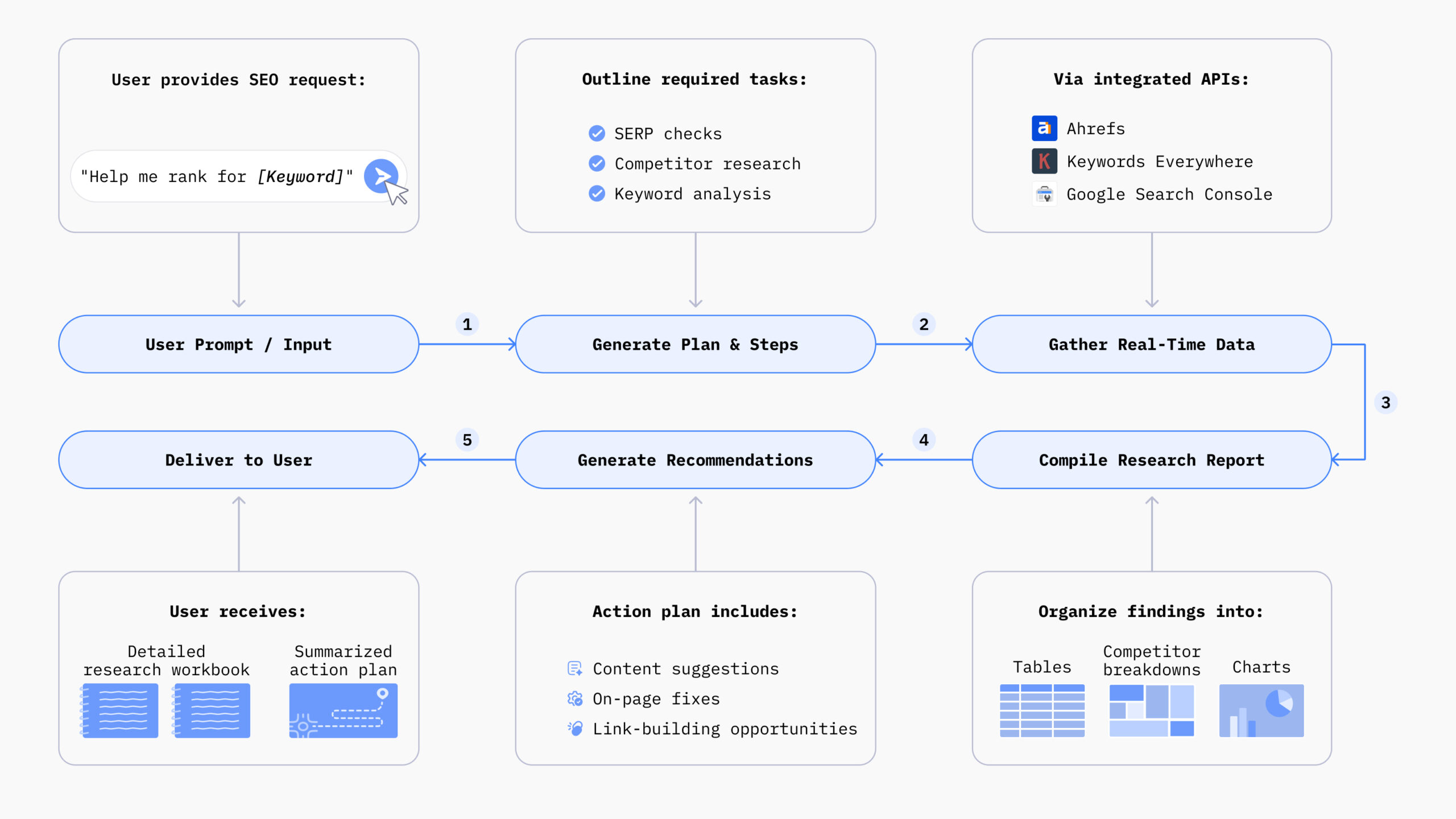What is outsource content writing?
Outsourcing content writing means hiring external writers to create content for your business instead of relying on an in-house team.
This strategy helps you maintain a steady stream of high-quality content without the overhead of full-time staff.
Outsourcing typically involves:
- Ideation and planning: Generating fresh ideas and creating content outlines.
- Writing and editing: Skilled writers craft and polish content, including blogs, articles, social media posts, and landing pages.
- Visual content creation: Collaborating with designers to produce infographics and other visuals.
And content outsourcing is more common than you might think:
- 56% of companies outsource content writing. [1]
- 69% of businesses report outsourcing blog writing helps them publish more consistently. [1]
- 34% of companies spend $1,000 to $5,000 monthly on outsourced content. [2]
Outsource content writing helps you create a strategic, scalable approach to your content calendar, allowing your team to focus on other critical tasks.
For example, if your goal is to publish 30 B2B articles per month, outsourcing blog posts can help you achieve that without overloading your in-house resources.
Some other benefits of outsourcing content writing include:
- Cost-effective: You only pay for the content you need, saving on full-time salaries and benefits.
- Access to top-tier expertise: Tap into a pool of talented writers with specialized skills, and no geographical limitations.
- Faster turnaround: Outsourcing saves time, enabling your team to focus on high-priority tasks.
- Consistent output: A steady flow of content ensures your marketing efforts stay on track, even during busy times.
- Fresh perspectives: External writers bring new ideas and angles, helping keep your content engaging and creative.
Also read: SEO Writing: Proven Tips for Creating SEO-Optimized Content
When to consider outsourcing content writing
Outsourcing content writing can be a game changer for many businesses, but it’s not the right choice for everyone.
For example, outsourcing writing will be unnecessary if you already have a robust team of in-house writers who can do the job well.
Content optimization tools can automate the writing process if you prefer a more hands-off approach.
Writesonic is a great option for high-quality, fact-checked AI-generated content. It automates blog writing and offers a full range of content creation and SEO tools, all in one platform.
In case you’re still considering outsourced content, here are some signs to look out for:
1. You’re struggling to keep up with content demands
Outsourcing is ideal if your team is constantly behind on your content calendar or you can’t produce enough content to meet your marketing goals.
By choosing to outsource content writing, you can maintain a consistent publishing schedule without overloading your in-house team.
This ensures your content marketing strategy stays on track while freeing up your team to focus on core tasks.
2. You need specialized expertise
Sometimes, your in-house team may lack the depth of knowledge required for specific topics.
Outsourcing content allows you to tap into a pool of skilled writers with diverse expertise. This is perfect for when you have certain content pieces that require an expert opinion or approach.
Whether you need highly technical articles or niche industry content, outsourcing article writing ensures your content is well-researched and high-quality.
3. You want to cut costs
Hiring and maintaining a full-time in-house content team can be expensive.
From salaries to benefits and overhead, the costs quickly add up. Outsourcing writing services allows you to avoid these expenses while still ensuring high-quality content production.
In fact, there is a common misconception that outsourcing content needs is more expensive than an in-house team. However, this is not necessarily the case.
The cost of outsourcing and insourcing can vary depending on several factors, including the task’s complexity and the company’s internal costs.
Plus, with outsourcing, you pay for exactly what you need–nothing more.
4. You want to improve your SEO
SEO is a critical part of any content strategy. However, creating SEO-optimized content requires expertise.
Outsourcing content writing to experienced writers who specialize in SEO can help you achieve better search engine rankings. Working with experts allows you to allocate your resources more efficiently and focus on other important business tasks.
Outsourcing SEO tasks is also great for those who need very specific expertise, such as technical enhancements or off-page help.
5. You need content in multiple formats
If you’re looking to diversify your content, such as blog posts, whitepapers, eBooks, or social media content, outsourcing content writing services can help.
When you outsource writing, you gain access to specialists in various content types without needing to rely on full-time employees.
This way, you can cover all content bases with minimal overhead, plus employees won’t be burdened with extra work.
Should you outsource content writing or keep it in-house?
Here’s a quick comparison between leveraging an in-house team of writers and outsourcing content writing:
| Criteria | Outsource content | In-house writers |
| Quality control | Quality won’t always be consistent | Easier to maintain stringent quality control |
| Expertise | Access to specialized writers with diverse knowledge | Consistent with company values and brand voice |
| Scaleability | Easily scale production up or down as needed | Limited by internal resources and capacity |
| Cost | Generally more cost-effective, especially for specific projects | Higher ongoing costs due to salaries and benefits |
| Resource management | No need to invest in training and development | Requires continuous investment in skill development |
| Flexibility | Can hire per project or on a short-term basis | Commitment to long-term employment |
AI writing tools are indispensable for in-house content teams. That’s why Writesonic is something you should consider for your tech stack.
Writesonic’s AI Article Writer generates high-quality content quickly, saving time and effort. This allows teams to focus more on strategy and creativity rather than the writing process.
The AI Article Writer can handle a wide range of topics, ensuring comprehensive coverage without sacrificing quality. It is user-friendly, making it accessible to everyone, even those who are not tech-savvy.
Writesonic also helps maintain a uniform tone and style across all content through custom content guidelines and brand voice. It also aids in scaling content production, so in-house teams can meet deadlines more efficiently and manage larger projects with ease.
How to outsource content writing: A step-by-step process
To help you start your content outsourcing journey, we’ve broken down 8 simple steps for a seamless process.
Step 1: Define your content needs, goals, and budget
Like any content strategy, outsourcing must start with clearly defining your team’s needs, goals, and budget.
Research suggests that publishing around 11 articles per month, or about four posts each week, produces the most traffic for most businesses.
Of course, this can vary depending on your company’s age, SEO goals, and content strategy.
Next, identify the purpose of your content. Is it to drive traffic, inform your audience, or encourage specific actions?
Communicate your content goals and guidelines clearly to your outsourced writers to ensure their output aligns with your objectives.
Finally, set a realistic budget and decide whether you’d like to pay per blog, per word, or on a contractual basis.
For example, freelance writers will generally charge between $25 and $100 per 500 words.
Here are some details on what outsourcing costs and plans can look like:
- Per-word rates can range between $0.05 to $1.00 per word. A 1,000-word article may cost between $50 and $250. Rates can vary based on a writer’s experience and project complexity.
- Per-hour rates can range from $15 to $20+ per hour. If a 1,000-word article takes 2 to 10 hours, the cost will be between $30 and $250.
- Per-project or per-article rates can range between $100 and $300+ per project. This type of model is ideal for one-time projects like white papers, eBooks, or website copy.
- Monthly retainer rates can range from $500 to $5,000+. This works best for businesses that need a consistent flow of content over time.
Step 2: Identify the type of writer you need
Once you’ve defined your content needs, goals, and budget, the next step is to identify the type of writer you need.
- Generalist writers: These writers can cover a wide range of topics and are versatile in their writing style. They are ideal for businesses that need content on various subjects.
- Specialist writers: Writers with expertise in a specific industry or niche. They are perfect for technical or highly specialized content that requires in-depth knowledge.
- SEO writers: These writers are skilled in creating content optimized for search engines. They understand keyword research, on-page SEO, and content structuring to improve search rankings.
- Copywriters: Focus on persuasive writing aimed at driving conversions. They are great for creating sales pages, ad copies, social media posts, email campaigns, and other marketing materials.
- Technical writers: Experts in explaining complex topics in a clear and concise manner. They are ideal for creating manuals, guides, and other technical documents.
- Ghostwriters: Write content on behalf of someone else, often without receiving credit. They are useful for creating content that needs to match a specific voice or style.
- Thought leader writers: These writers create authoritative content that positions you as an expert in your field. They are ideal for whitepapers, opinion pieces, and industry insights.
When choosing the type of writer for your outsourced content, consider their expertise as well. Some content pieces may require less expertise, so ensure you don’t overpay for your service.
For example, if you need someone to handle ad campaigns, it won’t make sense to outsource a thought leader writer who will obviously charge more.
Step 3: Develop a content plan
The next step is to create a content plan that outlines your strategy, topics, and publishing schedule.
Start by defining your content strategy, which includes setting objectives, identifying your target audience, and deciding on the types of content you need.
Conduct thorough topic research and create a content calendar that outlines your topics and publishing schedule.
For an organized content planner, consider creating a Google sheet with columns and rows for the task owner, due date, publishing date, current status, and any other details necessary to your scope of work.
Here’s a sample format you can use:
Your plan should also consist of content briefs that include key points, SEO guidelines, and style guides. Establish a workflow with clear deadlines, review processes, and quality control measures.
Tools like Asana, Slack, and Notion are great ways to manage tasks and store content centrally.
Finally, plan for content distribution and regularly measure performance to adjust your strategy as needed.
Step 4: Vet and select writers
When evaluating potential writers, ask yourself these questions:
- Have they produced similar content to what you need?
- Do they have experience working with brands like yours?
- Can they provide examples of their work?
- Do they have a good working relationship with their editor?
- What types of milestones do they use to track their content output?
Remember that different writers specialize in various niches.
Determine whether you need a writer with expertise in your industry or someone with a broader skill set.
For example, if you’re in the tech industry, finding a writer with a background in technology can ensure they understand the nuances of your content.
You’ll also need to evaluate the writer’s brand voice. Ensure the writer’s style and tone match your brand’s personality. Review their portfolio to see if their previous work aligns with your expectations.
Also, look for writers who understand SEO best practices, including keyword research, on-page optimization, and content structuring.
This ensures your content is engaging and optimized for search engines.
Here’s a quick checklist so you can easily remember the essentials for vetting writers:
Step 5: Set clear expectations and deadlines
When you finally have a team of outsourced writers, clearly communicate your expectations, brand guidelines, and content goals to ensure alignment and consistency in your content strategy.
As a best practice, consider creating a common Google Drive folder for your outsourced writers that explains your team’s processes, brand voice and content guidelines, and a calendar defining deadlines.
Be sure to keep everyone in the loop through a common communication channel to avoid slip-ups.
A single trusted source of documentation can help establish trust and clear expectations.
Step 6: Provide necessary resources and support
When you hire new employees, you must invest time in their onboarding by sharing necessary resources and additional support.
The same applies to an outsourced team of writers.
Share insights about your business, industry, and target audience with your outsourced team members.
The more they understand your company, the better they can create helpful content. Ensure they have access to necessary content writing tools, style guides, and any other resources they might need to produce high-quality work.
Step 7: Implement a feedback and revision process
Regular feedback is essential for improving the quality of your outsourced blogging.
So, take the time to provide constructive feedback based on your preferences, audience feedback, and performance metrics.
This helps writers understand your expectations better and refine their content to meet your needs.
You should also establish a streamlined process for revision requests and outsource writers. Consider pairing them with an internal team member responsible for reviewing their work.
Step 8: Monitor progress and content quality
With all these steps in place, always monitor the performance of your outsourced content to measure its effectiveness.
Monitor key metrics such as engagement, traffic, conversions, and ROI to assess the impact of your content creation efforts.
Use this data to refine your content strategy and optimize future content creation projects. These metrics are crucial as they can help you determine whether your investment in outsourcing blog content is really paying off.
Top 10 platforms for outsourcing content writing services
1. Writesonic – Best for in-house content creation and SEO optimization
Writesonic is the perfect tool for in-house writers who want to speed up their workflow. The platform offers both content writing and SEO optimization tools in one place, so you don’t have to keep switching between tools.
You can generate everything from blog posts to social media posts, and it integrates well with SEO tools for optimizing your content for SERP rankings.
Key features of Writesonic for in-house teams include:
- AI-driven content generation: Generate articles, product descriptions, and other content in seconds, tailored to your brand’s voice.
- Real-time fact-checking: Unlike other AI content tools, Writesonic and its marketing-oriented ChatGPT alternative, Chatsonic, offer real-time access to verified, fact-checked data. This ensures that your content is accurate and relevant, saving time on manual verification.
- SEO optimization tools: Writesonic’s built-in SEO checker helps you optimize content for search rankings, improving visibility and driving organic traffic. It also grades your content and offers suggestions to improve SEO performance.
- Content automation: Save time with tools that generate everything from blog outlines to full-length articles, freeing your team to focus on strategy and creative tasks.
- Customizable templates: Whether you’re drafting a blog post or creating a marketing email, Writesonic’s templates are customizable to fit your needs, maintaining consistency across your content.
2. Upwork – Best for hiring freelance content writers
Upwork is a global platform that allows businesses to hire freelance writers for various content types.
Whether you need blog posts, articles, website copy, or technical content, you can find writers with expertise in your niche. It’s perfect for businesses that need flexibility and want to handpick their writers.
Key features:
- Wide selection of freelance writers.
- Ability to filter by expertise, experience, and ratings.
- Secure payment system with tracking for milestones.
3. Draft – Best for ongoing content production
Try Draft if you’re looking for a service that provides quick, consistent, high-quality content with minimal management.
Draft a subscription-based service that pairs you with professional content writers for ongoing projects like blog posts, articles, and more.
This is a great choice if you’re looking for a steady stream of content without the hassle of onboarding freelancers individually.
Key features:
- Subscription-based model for regular content.
- Skilled content writers vetted by the platform.
- Simple content request and delivery process.
4. Verblio – Best for niche-specific content
Verblio specializes in providing high-quality, niche-specific content by connecting businesses with experienced writers in various industries.
Whether you’re in B2B, healthcare, tech, or finance, Verblio can match you with writers who understand your field and audience.
Key features:
- Writers specialize in a wide range of industries.
- High-quality content with a focus on niche markets.
- Content creation tailored to specific buyer personas.
5. Fiverr – Best for quick and budget-friendly content
If you’re on a tight budget or need quick turnarounds, Fiverr is a go-to platform for outsourcing content writing services.
This platform is best for small businesses or startups needing affordable and fast content for social media, blog posts, or website copy.
With a wide range of writers available at various price points, you can find someone who fits your project needs without breaking the bank.
Key features:
- Low-cost content writing services.
- Quick turnaround times.
- A wide variety of content formats, from blog posts to product descriptions.
6. Textbroker – Best for bulk content orders
Textbroker is ideal for companies needing to outsource large volumes of content, such as blog posts, product descriptions, or press releases.
Writers are categorized based on quality levels, so you can choose the writer who best fits your content needs and budget.
Key features:
- Content available in different quality levels.
- Bulk content orders at competitive prices.
- Easy-to-use platform with an intuitive interface.
7. ClearVoice – Best for content strategy and high-end projects
ClearVoice offers a more holistic content marketing approach, providing not only content writing services but also content strategy and management.
It’s ideal for businesses looking to build a strong content marketing campaign with a long-term partnership. The platform connects you with a curated network of professional content creators, editors, and strategists.
Key features:
- Access to high-quality, vetted writers and editors.
- Content strategy development and project management tools.
- Ability to scale content teams as needed.
8. WriterAccess – Best for content marketing and scaling teams
WriterAccess focuses on providing businesses with scalable, high-quality content by matching them with professional writers and even translators who understand SEO and content marketing.
The platform allows you to create custom workflows and easily manage multiple projects at once. The platform also offers managed services, where experts handle your entire content strategy.
Key features:
- Content creation, strategy, and management in one platform.
- SEO-optimized content created by experienced writers.
- Customizable workflows and managed services.
9. Copify – Best for all-round digital marketing needs
Copify is a full-service digital marketing agency that offers a range of solutions, including content writing, SEO, PPC, and more.
The platform provides a streamlined approach for businesses looking for scalable content creation without the need for in-house teams.
They deliver tailored strategies that align with your goals and help drive measurable results.
Key features:
- Services include SEO, PPC, content creation, website development, and conversion rate optimization (CRO).
- Serves healthcare, real estate, e-commerce, and digital marketing industries.
- Fast content delivery with a rigorous quality assurance process.
- Offers industry-specific strategies for better ROI and audience engagement.
- Proven track record with brands like AutoTrader, LookFantastic, and Lyca Mobile.
Copify helps businesses achieve their marketing goals through well-researched, high-quality content and a broad digital marketing toolkit.
Whether you need SEO-optimized blog posts, ad copy, or full-service digital campaigns, Copify provides an integrated solution for scaling your online presence.
10. Contently – Best for enterprise-level content production
Contently is a content outsourcing platform designed for enterprise-level content production. It connects businesses with experienced writers, editors, and creatives to produce top-tier content that aligns with your brand voice.
With content strategy consulting and high-quality content management, it’s perfect for larger organizations.
Key features:
- Enterprise-level content strategy and project management.
- Access to a curated network of top-tier writers and designers.
- Analytics tools for measuring content performance.
Best practices for managing the outsourcing process
Outsourcing content writing can transform your content strategy, but to ensure a seamless and productive partnership, following these best practices will help maximize your results:
1. Provide detailed feedback
Clear and constructive feedback is crucial for aligning your outsourced content with your expectations.
Avoid giving generic feedback like, “I don’t like this. Please change it.”
Instead, always ensure your feedback is clear and actionable.
Example: “This section may not connect with our audience well. Can you look into more specific industry examples from similar organizations?”
Be sure to take the time to review the content thoroughly and highlight areas for improvement.
This helps writers understand your preferences, tone, and brand nuances, ultimately leading to higher-quality content.
2. Avoid content mills
Content mills are platforms where freelancers produce high-volume content at budget-friendly rates. While they’re great for quickly getting lots of basic content, you won’t get to choose specific writers or find niche experts.
Since these platforms pay less, most writers there are typically newcomers to the field.
These platforms may not provide the specialized expertise needed for more complex topics.
Instead, focus on working with freelancers or agencies with industry experience and a proven track record of delivering high-quality, customized content.
3. Track performance and iterate
Monitor the performance of your outsourced content using metrics like engagement, traffic, and conversions regularly.
Analyze what’s working and what’s not and iterate on your strategy. This data-driven approach ensures continuous improvement, allowing you to refine your content over time.
4. Focus on long-term relationships, not just one-off projects
Building long-term relationships with your writers creates a sense of loyalty and consistency. Writers who are familiar with your brand will better understand your content needs, voice, and target audience, leading to smoother collaboration and better results over time.
5. Communicate clearly and provide detailed briefs
Communication is key to any successful outsourcing relationship.
Always provide a comprehensive brief that outlines the scope of the project, key topics, tone, SEO requirements, and any other specific instructions.
The clearer you are, the better your outsourced team will be able to deliver content that meets your expectations.
Here’s an example of what a content brief can look like:
Automate and scale your in-house content strategy with Writesonic
Creating high quality, SEO-friendly content is tough when managing an in-house marketing team. The costs add up, and juggling multiple tools gets overwhelming.
That’s where Writesonic steps in–the perfect AI content companion that helps you create amazing content effortlessly.
Why in-house teams love Writesonic:
- Cut outsourcing costs: Say goodbye to expensive freelancers or agencies. Writesonic allows your team to produce high-quality content in-house. No more waiting on third parties, and no more unexpected price hikes.
- End-to-end content workflow: From planning and research to writing, optimization, and publishing, Writesonic covers it all. With the AI Article Writer, your team can produce content faster—while maintaining the depth of research, SEO optimization, and quality writing that your audience expects.
- Smart, scalable SEO optimization: Chatsonic, an awesome ChatGPT alternative, goes beyond content creation. The Marketing Mode feature acts as your virtual marketing consultant, guiding you through smarter SEO strategies and keyword research. All within a single platform.
- Real-time web research and competitor analysis: Stay ahead of the curve with the latest trends. You’ll get fact-checked content every time. Say goodbye to AI hallucinated content. Writesonic digs deep into competitor strategies, enabling your team to craft superior content that ranks higher and drives traffic.
- Customizable brand voice: Whether you need a fun, conversational tone or a professional, authoritative voice. Now, you can create a brand voice that resonates with your audience—no need to spend hours editing for tone and style.
- SEO tools built-in: No need to juggle between different platforms. Writesonic offers automated internal linking, SEO audits, content gap analysis, and real-time performance tracking—all in one place.
With Writesonic’s comprehensive suite of AI tools, your team can create, optimize, and publish SEO-optimized content more efficiently than ever before—without compromising on quality.
Ready to ditch outsourcing? With Writesonic, you’re in control.
Start creating with Writesonic today.
Frequently asked questions
1. How much does it cost to outsource content writing?
The cost of outsourcing content writing can vary widely depending on the pricing model and the writer’s experience.
Generally, per-word rates range from $0.05 to $1.00, with more experienced writers or complex topics costing more. For hourly rates, expect to pay between $15 and $20 per hour, with the time to complete a 1,000-word article ranging from 2 to 10 hours.
Per-project rates are typically between $100 and $300, while monthly retainer rates for consistent content can start from $500 and go up to $5,000 or more.
2. How do I ensure the quality of outsourced content?
Establishing clear communication from the start is essential to ensuring the quality of outsourced content.
Providing detailed briefs, setting expectations, and giving specific feedback are key. Reviewing samples before committing to a long-term project and working with experienced, reputable writers or agencies will also help maintain high standards.
Regularly evaluate the content’s performance and relevance to your audience to ensure it meets your goals.
3. Can I outsource SEO-optimized content?
Yes, you can outsource SEO-optimized content, but it’s crucial to work with writers who are knowledgeable about SEO best practices.
Platforms like Writesonic, which provide AI tools for SEO research, content optimization, and keyword analysis, can help produce content that ranks well in search engines while maintaining quality.
4. How do I protect my brand voice when outsourcing?
To protect your brand voice when outsourcing, it’s important to provide detailed guidelines on tone, language, and style.
Use content templates that align with your brand’s messaging and review drafts before publication.
Providing feedback and examples of previous content can help maintain consistency. Additionally, collaborating closely with the writer and making adjustments as needed will ensure that the final output feels authentic to your brand.
Footnotes:
















![How to Use ChatGPT for SEO: 10+ Strategies [Tips and Tricks]](/wp-content/uploads/4-1-1.png)











